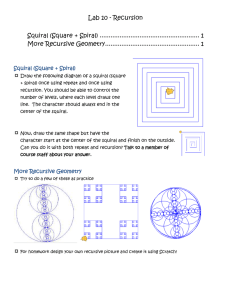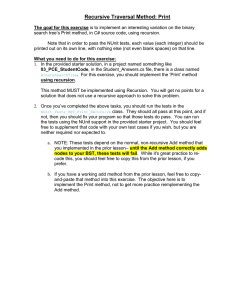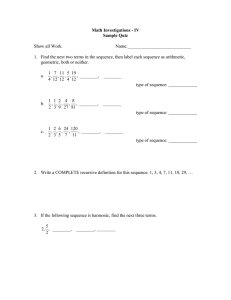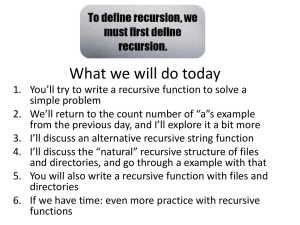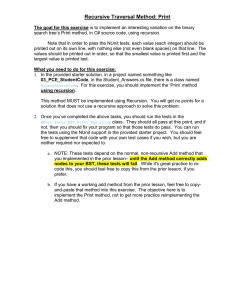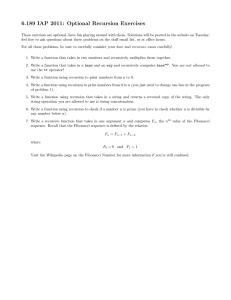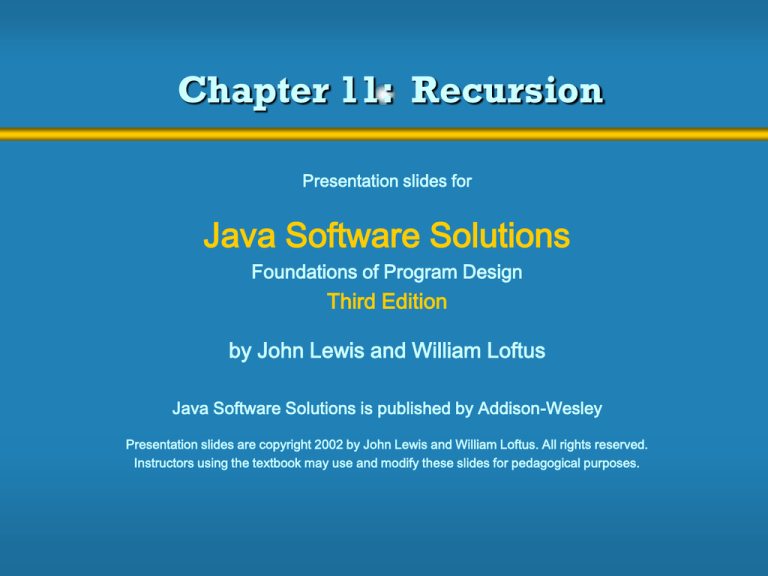
Chapter 11: Recursion
Presentation slides for
Java Software Solutions
Foundations of Program Design
Third Edition
by John Lewis and William Loftus
Java Software Solutions is published by Addison-Wesley
Presentation slides are copyright 2002 by John Lewis and William Loftus. All rights reserved.
Instructors using the textbook may use and modify these slides for pedagogical purposes.
Recursion
Recursion is a fundamental programming technique that
can provide elegant solutions certain kinds of problems
Chapter 11 focuses on:
•
•
•
•
•
thinking in a recursive manner
programming in a recursive manner
the correct use of recursion
examples using recursion
recursion in graphics
2
Recursive Thinking
Recursion is a programming technique in which a method
can call itself to solve a problem
A recursive definition is one which uses the word or
concept being defined in the definition itself; when
defining an English word, a recursive definition usually is
not helpful
But in other situations, a recursive definition can be an
appropriate way to express a concept
Before applying recursion to programming, it is best to
practice thinking recursively
3
Recursive Definitions
Consider the following list of numbers:
24, 88, 40, 37
A list can be defined recursively
A LIST is a:
or a:
number
number
comma
LIST
That is, a LIST is defined to be a single number, or a
number followed by a comma followed by a LIST
The concept of a LIST is used to define itself
4
Recursive Definitions
The recursive part of the LIST definition is used several
times, ultimately terminating with the non-recursive part:
number comma LIST
24
,
88, 40, 37
number comma LIST
88
,
40, 37
number comma LIST
40
,
37
number
37
5
Infinite Recursion
All recursive definitions must have a non-recursive part
If they don't, there is no way to terminate the recursive
path
A definition without a non-recursive part causes infinite
recursion
This problem is similar to an infinite loop with the
definition itself causing the infinite “loop”
The non-recursive part often is called the base case
6
Recursive Definitions
Mathematical formulas often are expressed recursively
N!, for any positive integer N, is defined to be the product
of all integers between 1 and N inclusive
This definition can be expressed recursively as:
1!
N!
=
=
1
N * (N-1)!
The concept of the factorial is defined in terms of another
factorial until the base case of 1! is reached
7
Recursive Definitions
120
5!
24
5 * 4!
4 * 3!
6
3 * 2!
2 * 1!
2
1
8
Recursive Programming
A method in Java can invoke itself; if set up that way, it is
called a recursive method
The code of a recursive method must be structured to
handle both the base case and the recursive case
Each call to the method sets up a new execution
environment, with new parameters and new local
variables
As always, when the method execution completes,
control returns to the method that invoked it (which may
be an earlier invocation of itself)
9
Recursive Programming
Consider the problem of computing the sum of all the
numbers between 1 and any positive integer N, inclusive
This problem can be expressed recursively as:
N
N-1
=
N
i=1
=
+
N-2
=
i=1
N + (N-1) +
i=1
etc.
10
Recursive Programming
public int sum (int num)
{
int result;
if (num == 1)
result = 1;
else
result = num + sum (num - 1);
return result;
}
Recursive Programming
result = 6
main
sum(3)
sum
result = 3
sum(2)
sum
result = 1
sum(1)
sum
12
Recursion vs. Iteration
Just because we can use recursion to solve a problem,
doesn't mean we should
For instance, we usually would not use recursion to solve
the sum of 1 to N problem, because the iterative version
is easier to understand; in fact, there is a formula which
is superior to both recursion and iteration!
You must be able to determine when recursion is the
correct technique to use
13
Recursion vs. Iteration
Every recursive solution has a corresponding iterative
solution
For example, the sum (or the product) of the numbers
between 1 and any positive integer N can be calculated
with a for loop
Recursion has the overhead of multiple method
invocations
Nevertheless, recursive solutions often are more simple
and elegant than iterative solutions
Indirect Recursion
A method invoking itself is considered to be direct
recursion
A method could invoke another method, which invokes
another, etc., until eventually the original method is
invoked again
For example, method m1 could invoke m2, which invokes
m3, which in turn invokes m1 again until a base case is
reached
This is called indirect recursion, and requires all the same
care as direct recursion
It is often more difficult to trace and debug
15
Indirect Recursion
m1
m2
m3
m1
m2
m1
m3
m2
m3
16
Maze Traversal
We can use recursion to find a path through a maze; a
path can be found from any location if a path can be
found from any of the location’s neighboring locations
At each location we encounter, we mark the location as
“visited” and we attempt to find a path from that location’s
“unvisited” neighbors
Recursion keeps track of the path through the maze
The base cases are an prohibited move or arrival at the
final destination
Maze Traversal
See MazeSearch.java (page 611)
See Maze.java (page 612)
Towers of Hanoi
The Towers of Hanoi is a puzzle made up of three
vertical pegs and several disks that slide on the pegs
The disks are of varying size, initially placed on one peg
with the largest disk on the bottom with increasingly
smaller disks on top
The goal is to move all of the disks from one peg to
another according to the following rules:
• We can move only one disk at a time
• We cannot place a larger disk on top of a smaller disk
• All disks must be on some peg except for the disk in transit
between pegs
Towers of Hanoi
To move a stack of N disks from the original peg to the
destination peg
• move the topmost N - 1 disks from the original peg to the extra
peg
• move the largest disk from the original peg to the destination peg
• move the N-1 disks from the extra peg to the destination peg
• The base case occurs when a “stack” consists of only one disk
This recursive solution is simple and elegant even though
the number of move increases exponentially as the
number of disks increases
The iterative solution to the Towers of Hanoi is much
more complex
Towers of Hanoi
See SolveTowers.java (page 618)
See TowersOfHanoi.java (page 619)
See Figures 11.5 on page 616 and 11.6 on page 617.
Summary
Chapter 11 has focused on:
•
•
•
•
•
thinking in a recursive manner
programming in a recursive manner
the correct use of recursion
examples using recursion
recursion in graphics

